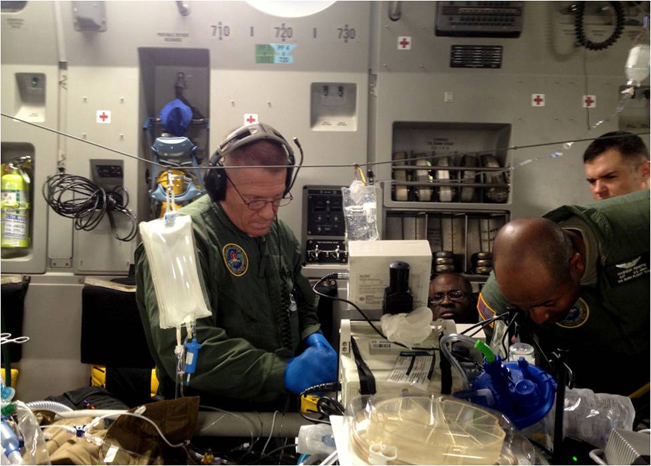ISR Burn Flight Team Completes Record-Breaking Mission

For more than 60 years, the U.S. Army Institute of Surgical Research Burn Center at Joint Base San Antonio, Fort Sam Houston, Texas, has provided specialized medical response through its Burn Flight Team, to deploy and transport burn and critically injured patients throughout the world to the ISR Burn Center for definitive care. On February 22, the team set a new record for the longest continuous flight by flying for 19 hours on a non-stop flight from Singapore to San Antonio, and traveling more than 9,850 miles, surpassing its previous longest flight by more than 3,000 miles.
Since its inception in 1952, the BFT has been able to deploy its five-person teams year-round within hours of notification of a mission. The specialized team is normally composed of a burn surgeon specialized in critical care, a critical care registered nurse, a licensed vocational nurse, respiratory therapist, and an operations non-commissioned officer. The team usually departs from the San Antonio International Airport on a commercial flight with all the specialized critical care equipment necessary to transport one or more patients on an Air Force C-17 configured for patient care en route to San Antonio.
For the last decade, the BFT has conducted almost 100 missions between Landstuhl Regional Medical Center in Germany, and transported more than 350 patients injured in Afghanistan and Iraq. The recent mission to Singapore provided unique challenges for the team as they transferred the patient from the hospital to the aircraft and on to San Antonio. According to Lt. Col. (Dr.) Booker T. King, team leader and Burn Center deputy director, the mission went precisely according to plan with a combined effort from all the branches of the U.S. military, the International SOS organization, and the TRICARE Pacific Area office.
"The success of the mission relied on all these agencies working together in order to coordinate multiple aspects of the transfer beyond that which we normally experience when flying in and out of Germany," said King.
In order to make this mission a success, Army team members synchronized their efforts with the Marines on the ground; with the Air Force for the transport aircraft, the Navy for ground transportation and storage of the equipment in Singapore; and the ISOS and TRICARE for the care management and transfer of the patient from the hospital to the aircraft.
"The success of the recent Burn Flight Team mission to Singapore exemplifies the dedication of military professionals demonstrating limitless commitment to care for their brothers and sisters in arms," said ISR Burn Center director, Col. (Dr.) Evan Renz. "It also reflects the collaborative efforts of a tri-service team whose skills have been honed over a decade of combat support."
As with all transport missions, highly trained personnel and specialized equipment are used to stabilize the patient for the long flight home. Both Air Force Critical Care Air Transport Teams and BFT can be utilized to transport burn casualties.
"Many burn patients are transported by CCATT," said King. "We are usually involved with patients who sustain burns over 40 percent of their body or those with inhalation injuries."
King also explained that the BFT is ideally suited to care for casualties with complex traumatic injuries'such as those with a combination of burns, amputations, chest, abdominal and head injuries.
The six team members on the Singapore mission were King; Cpt. Michael A. Campbell, a critical care nurse; two licensed vocational nurses -- Sgts. Macneil Ramos and Nikenson Pennette; and two respiratory therapists -- Staff Sgts. Seth B. Holland and Daniel J. Nelson.
"Everyone on this team has to be proficient with their job," King said. "Also, it's not uncommon for a team member, for example a respiratory technician to assist the nurse and help with wound care while we are mid-air. We all work as a team for the benefit of the patient."
Not all Soldiers assigned to the Burn Center will become members of the BFT. Before anyone is selected to be a member of the team they have to work on the burn ward for many months and be selected from among their peers.
"And successfully complete Air Force CCATT training," said Holland, who has been with the BFT for more than a year.
Once a mission is complete, the BFT members immediately prepare for the next one and stand ready to live up to their motto, "Anytime, Anywhere."














